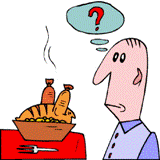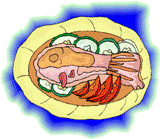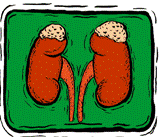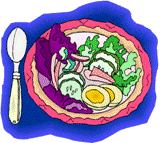|
|
Introduction
to Renal Nutrition |
|

When the kidneys fail:
- The food that we eat is broken down and used as building blocks for maintenance and growth by the body.
The excess products must be discarded, and this is the job of the kidney. When kidneys fail, they cannot eliminate
waste products, and these wastes accumulate and poison the body. This leads to a condition known as uremia.
- The waste products that accumulate are harmful to the body.
- The kidney also has the job of regulating fluids. In kidney failure, fluids and a mineral known as sodium (salt) can
accumulate, leading to high blood pressure and heart failure.
- Acids are minerals that can lower the body pH if not elimated or buffered. The kidney plays
a key role in this process, but in kidney failure, it loses its ability to do so, leading to acidosis.
- The body is made up of cells.The balance of potassium between body cells is very important to cellular function. Potassium cannot be
elimated when the kidneys fail, and accumulates. It can harm the body.
- Phosphorus is a mineral that is eliminated by the kidney. When it accumulated, it accumulated in the cells that surround
the blood vessels. This causes these cells to change into bone-type cells that harden and damage the blood vessels.
This interferes with blood flow, and also damages the heart.
- They fail to produce a hormone that fights anemia (low red blood cells)
- Vitamin D cannot be activated, interfering with bone and calcium metabolism, and ultimately leads to damaged blood vessels.
- The wastes that can harm the body come from
foods containing protein, acids, sodium, potassium, phosphorus, and
fluid.
|
|
What the kidneys do:
- They eliminate
waste products such as broken down proteins from the blood.
- They remove excess water
from the body.
- They regulate body acid levels.
- They maintain the proper
chemical and water balance by removing excess minerals and fluid
from the body.
- They activate vitamin D, a hormone vital to the body
- They produce a hormone that stimulates the production of red blood cells.
When the blood cells level is low, we say that anemia is present.
|
 |
| Renal:
"concerning the kidneys."Dialysis:
the process of removing wastes and maintaining the chemical balance
of blood when the kidneys no longer function. |
Chronic kidney disease is divided into five stages. These stages are classified based upon the glomerular filtration rate (GFR), a measure of
kidney function. The symptoms of kidney disease start to begin in Stage 3, when the GFR falls below 60 cc per minute. In this stage, the anemia, acidosis and bone disease begin. By Stage 4, when the GFR is less than 30 cc per minute, the appetite may start decreasing. It is in the fifth stage, when the GFR is less than
15 cc per minute, that the signs and symptoms of kidney disease worsen to the point that renal replacement therapy - dialysis or a kidney transplant - become necesessary.
When your kidneys do not function well, you may have uncomfortable
side effects such as a loss of energy, fatigue, irritability, trouble sleeping. Progressive kidney disease
kidney diseases causes a loss of appetite. You may feel ill. As the disease progresses, one can feel nauseated, confused, delirious, and even slip into a coma.
Since dialysis became readily available in the 1970s, the late stages of kidney failure have rarely been seen, but patients who miss dialysis treatments frequently
often have some of the early signs of uremia. The loss of appetite in the stages of kidney disease that precede dialysis may lead to malnutrition.
nausea, and high blood pressure. Dialysis removes waste products
from the body and helps decrease these side effects. In hemodialysis, blood is removed from the body and passes through a plastic filter. Here it comes in contact with a solution of electrolytes (charged atoms needed by the body, but dangerous in excess). The blood that has been "cleansed" is then pumped back to the body. The dialysis and filtration process that is performed here removes, wastes and fluid while replenishing back the necessary electrolytes. In peritoneal dialysis, a plastic tube is surgically placed in the peritoneal space of the abdomen - the area that surrounds the intestines - and fluid is allowed to dwell in the abdomen and then drain out. This fluid is
balanced, and thus removes the excess dangerous molecules and wastes while replenishing those elements that the body needs. Despites its ability to help sustain life and well being, dialysis
is not as efficient as normal kidneys. For instance, it cannot remove phosphorus. Furthermore, while the kidneys are working steadily for twenty-four hours a day, standard incenter hemodialysis is generally performed three days a week, and
there a waste products, as well as the acids, potassium, and sodium that build up between each
treatment. For these reasons, dialysis patients need to watch their fluids, keep their blood pressure and serum phosphorus under control, and
follow a special diet.
The renal dietitian is specially trained to work with people with kidney disease. The dietitian works with you and your family to assure that prior to
requiring dialysis, you receive a diet that will meet your needs while acocomodating your food
preferences and lifestyle. As disease progresses, and dialysis becomes necessary, the dietitian will change your diet.
Your diet plan may be modified periodically as your condition or type of dialysis changes.
Your dietitian will keep you informed of any changes needed in your diet.
|
Your Special Diet
- Provides adequate nutrition while limiting foods high in
sodium, potassium and phosphorus.
- Watching fluids and salt helps you keep your blood pressure in control by minimizing weight
gains between treatments.
- Watching your phosphorus and calcium intake helps keep your bones strong. It also greatly helps your blood vessels.
- Kidney patients have special vitamin supplements, and require more folic acid.
|
 REMEMBER!
Your diet and fluid intake, your medications and your dialysis therapy are equally important. Develop a
routine and stick with it to stay adherent to your treatment regimen. REMEMBER!
Your diet and fluid intake, your medications and your dialysis therapy are equally important. Develop a
routine and stick with it to stay adherent to your treatment regimen. |
 |
| Hemodialysis (Stage 5):
the type of dialysis that removes excess body wastes and fluids from
the blood as it passes through an artificial kidney. |
Types of Diet Therapy
CKD - Stage 1 - 4
When you are first found to have kidney disease, the goal will be to try to delay
the onset of kidney failure, prevent its complications (acidosis, anemia, worsening hypertension, bone/vascular
disease), and try to avoid the serious cardiovascular events common in CKD. The diet is a very important
part of this program. A "staying healthy diet" must be individualized based upon the underlying cause of your kidney disease. Fats, calories, carbohydrates, proteins, salt,
sugars, sodium, potassium and phosphorus may be modified. Your dietitian will help
you and your family make the necessary changes in your diet. Here are some resources.
American Heart Association
National Kidney Foundation - Nutrition Resources
American Society of Hypertension
American Diabetic Association
Nephron Information Center
|
| Dry
weight: the bodyís true weight, without excess fluid. |
Hemodialysis
Your blood is cleaned
several times a week with this type of dialysis therapy. Waste products,
toxic minerals, and fluid build up in the period between treatment. Thus, it is
important watch your closely when on dialysis. Most patients with kidney disease have hypertension, and
should limit their salt intake. Fluid intake must also be reduced if your urine output has decreased. This is
difficult to control, however, unless salt intake is limited.
Potassium and phosphorus are minerals that are toxic to the body. At this stage, you need to be aware of foods that are high
in phosphorus and in potassium. The USDA Nutrient Database will be very helpful.
In most cases you will need to eat more protein than was allowed
prior to receiving dialysis treatments. You will also need to eat
enough calories to keep from losing "dry weight" unless
otherwise planned with the dietitian.
The standard daily hemodialysis diet contains 80 grams protein (may vary), 2 - 3 grams of sodium, 2 grams potassium,
1500 cc (6 cups) fluid.
|
Rules for Eating During Your Dialysis Treatment if Permitted
- Some doctors allow patients to eat during dialysis. However, during dialysis the blood
flow to your stomach and intestines may be reduced if your blood pressure falls. This is because the body preferentally sends
blood to the brain in hypotension. If you have a tend to drop your blood pressure during treatments, you may not be
allowed to eat during treatments.
- The food that you eat during dialysis will not be digested immediately, and the breakdown products from that
meal will not be removed from your blood until your next treatment. THis needs to be taken into consideration when
developing your meal plan.
- During dialysis the fluid you gained between treatments must be removed as well as the fluid you drink while on the machine.
Thus, the pump must be set higher. There is a limit to how much fluid can be removed during a treatment, so be careful! Fluid restrictions
still need to be considered. Drinking excessive fluid during dialysis will makes it difficult to reach your dry weight.
- Therefore, donít ignore
your diet and fluids while you dialyze!
|
|
Peritoneal dialysis: (Stage 5)
a form of dialysis that uses the lining of the patientís abdominal
cavity, the peritoneum, for dialysis
Dialysate:
the solution used during dialysis to pull waste products out of
the blood.
|
Peritoneal Dialysis
Peritoneal dialysis is more constant than hemodialysis, and
has advantages with respect to diet. You will be able to liberalize your intake of
potassium and protein. In fact, many patients are on supplements because of increased
protein losses into dialysis solutions. However, the dialsate solution contains sugar. This
is to help remove body fluids. This sugar can be absorbed into the system and raise your blood
sugar. This can cause weight gains, and must be factored in when regulating insulin and diabetic meds.
Peritoneal dialysis patients will still need to watch their phosphorus very closely.
The standard diet for peritoneal dialysis patients is 100 grams protein (may vary),
4 grams sodium, four grams potassium, 2 liters (8 cups) fluid.
|
Kidney Transplantation (Stage 5)
Your transplant surgeon will probably ask you to lose weight before undergoing
transplant surgery. This is a worthwhile goal because it will help lower the risks of doing poorly while
on the new set of immunosuppressive medications required to sustain the transplanted kidney. After the successful
transplant, it is still important to watch your diet - keeping your weight, lipids and salt intake in balance.
Your diet will be adjusted based upon what antirejection medications you are taking.
Your doctor and your dietitian will create a meal plan that is tailored specifically to your current needs.
This diet can change as your medications and health status changes.
|
 General Guidelines
for Your Personalized Meal Plan General Guidelines
for Your Personalized Meal Plan
The foods on this plan
are divided into six groups according to the amount of calories,
protein, potassium, and phosphorus they contain:
- proteins (meats: foods like fish, beef, poultry)
- dairy (primarily milk, cheese, ice cream)
- carbohydrates(carbs: starches like bread, cake and pasta)
- vegetables (examples: spinach, corn, carrots, tomatoes, broccoli)
- fruits (examples: apples, oranges, pears, bananas,)
- fats(examples: butter, margarine, oils)
|  |
|
These food groups are called exchange lists because foods within
the same group may be exchanged for one another food in the same group to
build a daily meal plan. This web site,
The LoneStar Kidney Project,
has a textbox in the upper left hand corner
that is very useful in building your food list. Since kidney patients are asked to watch the content
of several nutrients in their meal, The USDA National Nutrient Database for Standard Reference, Release 17 (SR17) should also be
very valuable. With this online tool one can search either alphabetically or by nutrient quantity for nutrients
such as protein, fat, energy, carbs, fiber, calcium, phosphorus, potassium, sodium, etc. (Requires free Adobe Reader download)
To use the table below effectively, pay close attention to serving sizes as they may be more or less than you plan on using. Also, note how foods are packaged. Fresh and frozen foods are
preferred choices because they generally are lower in salt and phosphorus preservatives.
|
USDA Nutrient Database
| |
Alpha |
Content |
| Protein |
 |
 |
| Fat |
 |
 |
| Calories |
 |
 |
| Carbs |
 |
 |
| Fiber |
 |
 |
| Calcium |
 |
 |
| Phosphorus |
 |
 |
| Sodium |
 |
 |
| Potassium |
 |
 |
 Tips for Healthy Eating Tips for Healthy Eating
- Use the meal plan and stick with it.
- Volume of food is important - don't overeat.
- Talk with your doctor about adding new foods, but do not do this on your own.
Use the web to find new menus to keep your meal plans interesting.
- Weigh your foods with a food scale, measuring spoons and cups.
- Ask for help.
- Don't eat because you are stressed or depressed. It is normal to have periods of depression
and frustration with any chronic disease, especially kidney disease. But, taking it out on your body is
not the solution.
- Be careful at parties and social functions. Often the restaurant and host will accomodate you if you are
on a diet with special needs. Do not be ashamed to be on your diet. Over 50% of Americans are obese, 65 million of Americans have
hypertension and around 20 million have kidney disease. One million people die each year from heart disease, and strokes cost us 128 billion
dollars a year. Our diets are a major source of our health problems, and you are being a leader by stressing
healthy eating for yourself - and for others.
- Stick with it - You are going to have good and bad moments - but get back on track immediately.
- Celebrate your success - Praise yourself and seek praise from your health care team when you do well. You
deserve it. You will find that your providers are very proud of you when you do well. Compliment others when you
see them succeeding.
- Read labels: They will tell you about fat, sodium, potassium and the calorie intake. If you
do not do your own shopping, make sure that those who grocery shop for you know about the food content. If you still have problems
consult the USDA Nutrient Database below - You should bookmark this.
- Never use a "salt
substitute" because it contains potassium.
- Avoid salt shakers. They are a modern contrivance that only delivers toxins to you and your loved ones (hypertension runs in families).
- Do not cook with salt, and try to avoid foods that require preservation in salt. Once you reduce salt intake your body will adjust, and the foods you
eat will taste just as good. Keep in mind that we humans have been around for thousands of years, and survived without salt shakers all this time!!
|
| Examples:
Nutrient Content per Exchange or Serving (Source USDA SR17) |
|
Food Group |
Calories |
Protein (gm) |
Potassium (mg) |
Phosphorus (mg) |
Sodium (mg) |
Meat 100 gm (around 3 oz) |
200 |
26 |
323 |
201 |
53 |
Milk 2% fat (1 cup) |
138 |
10 |
448 |
276 |
145 |
Starches (slice bread) |
80 |
2 |
30 |
30 |
204 |
Vegetables (mixed,frozen, without salt) 1/2 cup |
59 |
2.6 |
156 |
46 |
32 |
Fruits (1 medium pear - 166 gm) |
96 |
.6 |
198 |
18 |
2 |
Fats (1 tbs margarine) |
457 |
0 |
4 |
10 |
90 |
|
|



 REMEMBER!
Your diet and fluid intake, your medications and your dialysis therapy are equally important. Develop a
routine and stick with it to stay adherent to your treatment regimen.
REMEMBER!
Your diet and fluid intake, your medications and your dialysis therapy are equally important. Develop a
routine and stick with it to stay adherent to your treatment regimen.
 General Guidelines
for Your Personalized Meal Plan
General Guidelines
for Your Personalized Meal Plan

 Tips for Healthy Eating
Tips for Healthy Eating